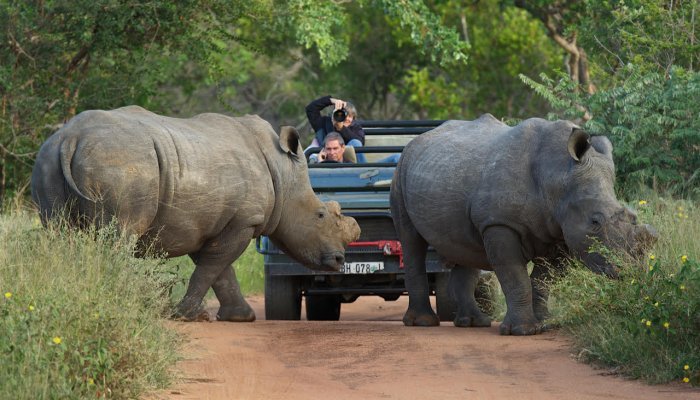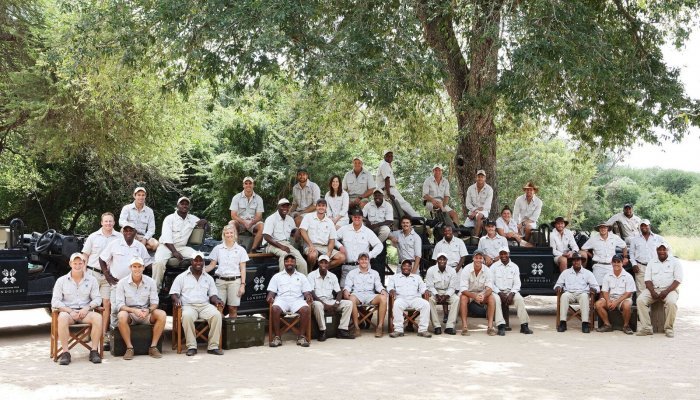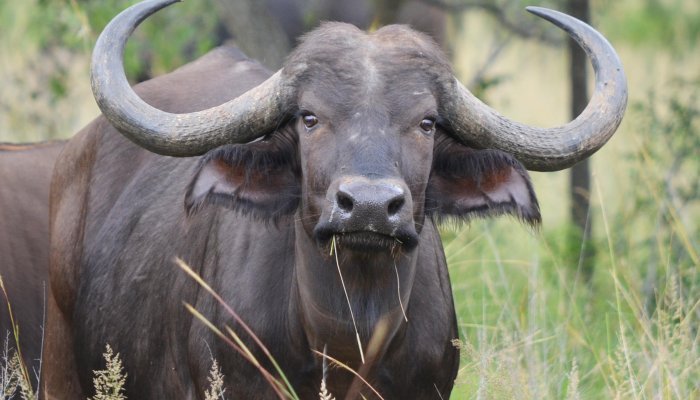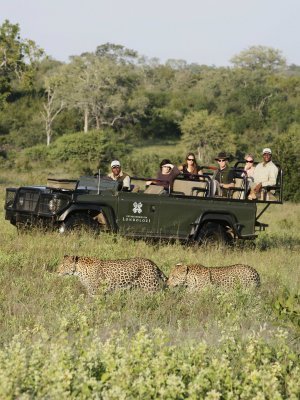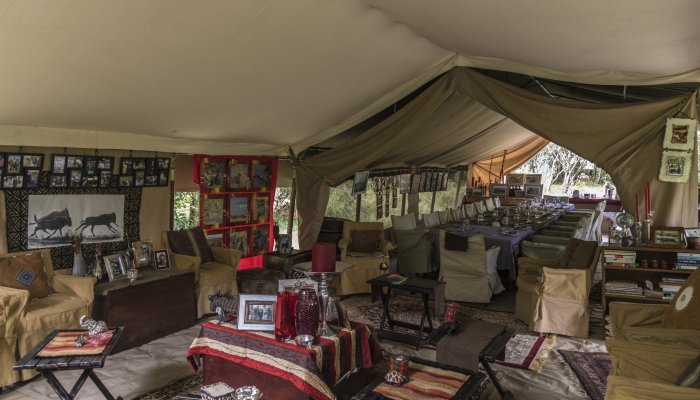Back in the day, our family would pile into my dad’s low-slung Valiant for the Kruger Park where we stayed in thatched rondavels with ant poison on the floor. We brought our own rusks and Rooibos; hardly roughing it compared to the late 1920s when rangers shared toothbrushes with forgetful park tourists, but the notion that a safari might one day require butlers, chandeliers and spas, was as foreign as fitbits.
In the mid-1970s, Londolozi and Mala Mala provided the only luxurious alternatives to the basic parks board camps at rates so eye-watering even Hollywood stars drew in their breath.
“In 1990 Mala Mala was charging $100 per person per night,” recalls Kevin Leo-Smith, a director of the Safari Investment Advisory for industry-specific expertise, and co-founder of safaris in South Africa, Botswana and Zambia. “That’s the year we started &Beyond's Phinda Game Reserve – KZN’s first private game lodge to cater to upper middle-class South Africans.”
From there, the concept sparked like burning savanna and today Leo Smith counts 150 private game lodges around Hoedspruit alone. He recommends game lodge owners get the ‘Five As’ right for repeat bookings and referrals:
· Access
Must be affordable, comfortable and easy to reach. If your land is remote, think self-sufficiency. You may have to generate electricity, supply your own water, and grow vegetables to thrive.
· Animals
Must include the iconic and general species expected of the area.
· Attitude
It’s all about the staff. An ideal manager should be able to repair a game vehicle, soothe a charging elephant (or have a tale about it) and look good in shorts carrying a rifle. Cellphones should be silent. Clients are not paying top dollar to hear a Dladla Mshunqisi ringtone while soaking up the raw power of the African bush.
· Architecture
This would include furniture, finishes, food, décor and camp set-up.
· Altruism
Let it shine. “Lodges that invest in their people at community level, get it right,” says Sharon Gilbert-Rivett, Africa Tourist Board member and co-founder of The Safari Collective SA. “Taking care of your people is a cornerstone of sustainable tourism. Happy staff make happy guests!”
Call of the Wild
For many, a safari is an Instagram-honed aspirational vacation with #fiftyshades_of_nature and #wanderlust hashtags. For others, it’s a vocation; a way to stalk those elusive tourist dollars. For the select few it’s a decades-long marriage. “Having a lodge is like having a wife,” says Dave Varty, whose family bought a depleted cattle farm in 1926 and turned it into Londolozi; a “successful family-run, single unit operation, with engaged staff and extraordinary wildlife”.
Sounds idyllic, but running a safari, warns Leo Smith, takes expertise, experience, time, creativity and deep pockets to succeed. “Often people believe they’ve bought an Eden, without finding out what else is out there. They fall for the old ‘build it and they will come’ logic; a big mistake.”
Jagged thorns ‒ from poaching to negative media attention, politics surrounding land security, and EWC threats ‒ line the dirt track to success. Drought in many parts and a struggling economy as potential investors prance like skittish impala scenting predators, add to the dung pile. “It’s the perfect storm,” says Limpopo buffalo breeder Alan van Coller. He’s weathered it so far. “Even though buffalo prices have dropped dramatically, I still make a good living,” he says.
Leo-Smith argues that the breeding market is highly competitive. “Giraffe and antelope are mostly worth their meat value sold live while wild lions, leopard and elephant are free at capturers’ risk and cost. It’s clear the mythical American Hunters are not going to pay a fortune for a semi-tame large-horned buffalo.”
Van Coller begs to differ. “There’s a shortage of the hard-boss ‘dagga boys’ so demand remains strong.”
Both agree policy insecurity is thinning the investment herd as bureaucracy proceeds with all the speed of a three-legged tortoise. Leo-Smith points out that “the EFF and ANC versions of EWC are not even closely aligned” but advises against approaching local community representatives to make ‘land claim deals’.
“Rather involve Land Affairs and the official Community Property Association, proceed through development approval, and comply with Environmental Impact Assessment conditions.”
Then there’s fractional ownership, where you buy a rotating cycle of weeks in a year and pay a steep levy for use of the lodge staff, food and game drives. Says Leo-Smith: “It’s an option, but not a license to print money.”
Safari Snares
Now that welcome drinks, rolled towels, crisp linens and beds under mosquito netting are de rigeur, safari owners might want to avoid some potential traps:
· Sacrificing the wilderness ethos on the altars of luxury
While producing Simply Safari, a coffee table book on lodge décor, wildlife photographer and author, Daryl Balfour felt irked by the whole ‘aspirational magazine focus’ at the expense of experiencing wildlife as the early hunters did ‒ “under canvas, at one with Nature.” Leo-Smith calls this “my decorator is better than yours” syndrome. In Balfour’s case, it motivated him to start two highly successful tented camps in Kenya’s Maasai Mara.
· Employing mediocre guides
“Being a guide is more than simply knowing how to ID a bird, mammal or tree,” says Balfour. “Even on disappointing game-spotting days, a great guide – sadly a rare breed – will keep guests enthralled. Many safari lodges employ barely-out-of-school youths, or locals, who interpret their role as driving a 4x4 around, pointing out animals. That’s it. This is partly due to labour legislation, but also a short-sighted way of cost-cutting.
“This has led to the rise of the private guide industry. Today, knowledgeable tourists book their safari with a GOAH – a good old Africa hand – to enhance their experience.”
· Allowing children on game drives
Don’t do it! Even more annoying than being subjected to the screams of a bored toddler that sent two elephants running for cover, was being told the lion section of a reserve was out of bounds, lest a big cat snatch the brat off the vehicle.
Agrees Balfour: “Predators react to distress calls, going on high alert to make a kill. A crying child sends out just such a signal. The only time we’ll accept anyone under 16 is if the family books out the entire camp.”
· Combining game viewing and hunting
The markets don’t mix. Choose one and stick to it, says Leo-Smith.
The rest of the safari pack
Here’s how other African countries compare:
· Botswana
Apart from the world-renowned Okavango Delta wilderness plus easy access via South Africa and its long-haul connections, around 40% of Botswana is under some form of wildlife land-use. Safari companies with exclusive, long-term concessions that enable off-road and night game drives, encircle the parks and game reserves.
· Namibia:
Easy to access via its own German and South African connections, Namibia has good infrastructure where it’s needed, and none where it’s not. It has an excellent combination of parks, game reserves, private areas and arguably the most successful community-based wildlife areas in the world. A great diversity of dramatic scenery and experience balances the lesser wildlife spectacles in places.
· Zimbabwe:
After decades of reputational difficulties, Zimbabwe can offer great internal circuits with high diversity such as Victoria Falls, Kariba, Zambezi River and traditional savanna wildlife choices. Access via South Africa is good, and the wildlife experience and tourism infrastructure are reasonable.
· Zambia:
While not as easy to access, involving longer travel times from South Africa, Zambia’s Livingstone, Lower Zambezi and South Luangwa areas offer world-class operations. However, safari industry logistics and infrastructure need improvement, particularly for self-drive visitors.
· Mozambique:
Other than excellent coastal and island offerings, Mozambique is still a developing situation with respect to safari tourism.
· Tanzania
Despite some governance challenges and logistical issues due to long distances between the northern and southern circuits, tourists flock here for the high diversity of wildlife scenery and experiences from islands to Africa’s highest mountain. The wildlife areas are huge compared to all other countries especially considering the surrounding sustainable use concessions with 35% of the country under conservation practice.
· Kenya:
Arguably the most tourism-focused country for traditional safaris with many good operations, excellent marketing has lured international tourists for decades with the diversity of experiences, scenery and wildlife, from deserts and beaches to alpine areas. Tourism structure is reasonable although some roads could be better. Ditto the main airport.
· Uganda:
Uganda’s high population density means wildlife areas are smaller and more isolated. Excellent great ape experiences as well as river, lakes and alpine diversity.
· Rwanda:
Quality gorilla and chimp viewing, plus the developing wildlife experience of Akagera, makes this new entrant to the safari scene a winner. Positive factors include the rapidly improving economy and infrastructure with an international airline.


